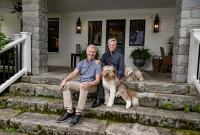Zeitgeist of Germany, circa 2006
By Michael Beadle
Editor’s note: Smoky Mountain News Writer Michael Beadle recently traveled to Europe. The following is the second of two stories about his experiences abroad.
Allzeit frohlich ist getährlich,
allzeit traung ist beschwerlich,
allzeit glücklich ist betrüglich,
eins ums andere ist vergnuglich.
Related Items
— Spruchweisheit
Always happy is dangerous,
always sad is depressing,
always lucky can betray you.
one after another is enjoyable.
— wise saying
To learn a place’s past is to know its future.
A left-leaning American born of Jewish ancestry and Catholic upbringing, I would have certainly been an enemy of the state had I lived in Germany only 65 years ago.
What a difference the decades make.
Once the site of World War II atrocities and a brutal dictatorship, Germany has risen from the ashes to become a unified nation, a world economic and political powerhouse that will serve as host of this year’s World Cup in soccer. Germany can also boast a native son as the current Pope Benedict XVI, and last year Germans elected Angela Merkel as the first female chancellor and youngest leader since World War II.
Germany has long been the center of attention in Europe, centrally located in the heart of the continent, strategically positioned in geopolitical alliances, and naturally home to key rivers and raw materials.
On a recent trip through Germany’s southeast corner, I fell in love with one of the iconic symbols of Germany’s past — the castle or Schloss. Having such a rich history of royalty, Germany is home to scores of castles and, perhaps more intriguing, castle ruins.
On our first stop in Weinheim at the edge of the Odenwald Mountains, my wife Nicole and I were fortunate enough to find respite at the home of our good (and gracious) friend, Lizbeth Kinney, who lives just a few blocks away from two castles — Schloss Windeck and Schloss Wachenburg.
The Two Schloss Tour
For an evening walk, Lizbeth served as our guide up two steep trails for a closer look at the town’s medieval past. At Schloss Windeck, built in 1100 and destroyed in the 17th Century, we found spectacular views of the town and surrounding countryside. The ruins of the castle’s tower and thick rock fortifications reminded me of the Alamo — a stairstepped, three-foot thick wall stubbornly remaining after mortar rounds blew chunks out to create an open cross-section like that of an illustration book where you see through various levels of a building.
From the base of Windeck, you get a sense of how medieval supremacy worked — build a castle on a steep slope with 360-degree views of any approaching attack and you should have a fairly good defense.
Yesterday’s fortress of battle cries now surrenders to clinking beer glasses and giggling children who play hide-and-go-seek among the ledges and compartments that were once lookout stations and jail cells. There’s a cozy restaurant inside the cavernous belly of the castle where guests can enjoy candlelit meals by reservation.
Climbing the stairs and standing at the top of Windeck’s tower, it’s hard not to imagine yourself as important, charged with the duty to survey your vast, make-believe kingdom. You might feel the urge to yell out an order of attack or maybe launch a few water balloons onto unsuspecting tourists. Retracing the steps of medieval soldiers, the places where swords once clashed and arrows were sent flying, you wonder if you could have survived back then living in cramped corners under the threat of plagues and religious wars that burned plenty at the stake.
At an even higher peak further up a mountainside trail stands Schloss Wachenburg, built between 1907 and 1928 and maintained as a military school for the local elite. The tower battlements, stone walls, tiled roofs, iron railings and stone courtyard are all very much intact. No battles here to speak of, save the ones for social and academic supremacy. Like a miniature Hogwart’s Castle, Wachenburg gives the allure of medieval mystery in its Gothic arches, shield displays and stone statues, but the antennas and more modern window frames on some buildings take away from some of the charm. So which will you find more appealing — the more authentic ruins of Windeck or the tidier, stately Wachenburg? Hard to say, though I enjoyed each for its lack of tourists. At evening, these sites are mostly vacant other than runners and cyclists who endure a great huff and puff to the top.
Schloss Heidelberg
Having seen my share of castles in England, the palace at Versailles, and perhaps the most famous Schloss of all in Neuschwanstein (Ludwig II’s fairy tale castle in southern Bavaria), I don’t surprise easily when touring through a house of royal repute. But on my first trip through Schloss Heidelberg, I immediately fell in love with the romantic city that has inspired poets and philosophers for centuries.
Home to Germany’s oldest university and an awe-inspiring medieval castle, Heidelberg is not a city you can see in one day, so we took train rides on our final two days of vacation to explore all we could.
Located on the Neckar River in the wooded foothills of the Odenwald Mountains and preserved as a scenic haven for tourists and students from all over the world, Heidelberg is one of the loveliest places in all of Germany to visit. The Philosophenweg (or Philosophers’ Walk) on one side of the river rises along a ridge that overlooks the city. Amid the cherry trees and flaming forsythia, birds and love-bird couples stroll in the footsteps of famous philosophers, scientists and writers who found their own quiet time communing with nature. Various gardens along the Philosopher’s Walk are maintained throughout the year, and slopes of vineyards and rolling pastures fill the landscape.
Crossing the Old Bridge into Heidelberg’s Altstadt (or old town) into the bustling Hauptstrasse, Heidelberg’s main street of shops and cafés, there are more than a dozen museums to explore.
The highlight of any trip to Heidelberg is a walk through the massive fortress looming on a hillside overlooking the city. First built around the 13th Century and destroyed in various attacks during the Thirty Years’ War and again by the French in the 17th Century, Schloss Heidelberg survives today as one of the premier examples of Gothic-Renaissance construction. Most of the castle buildings still standing were built between 1400 and 1620. Once the home to Prince Electors for three centuries, the castle offers a wide range of architectural designs from Gothic arches to richly adorned Renaissance and Baroque decorations to the almost surreal bare wall of Neo-Classical window openings (a lightning strike in 1764 caused a fire that burned down one of the main buildings).
Tour guides of all different languages take groups through the opulent living quarters, a pharmacy museum, and a sprawling, multi-level garden complex where the German poet Goethe found inspiration for Romanticism’s greatest verse. A memorial bust of Goethe rests in the lower level front garden.
While the tour brochures and guides provide plenty of facts and quirky stories about the castle, it’s also fun exploring the maze of passageways and dark corners of this site. Inside the castle’s deep grassy moat, the humidity of early spring turns suddenly cold as you feel your way along stones that rarely see the light of day. In the rear of the castle is the “Powder Tower,” where a gunpowder accident blew out the back side of its 20-foot thick walls.
Also a must-see on the tour: “the Great Tun,” an enormous wooden wine barrel that can hold 58,000 gallons. The mega-keg built in 1751 out of 130 oak trees has a dance floor on top. The walls around it are scribbled with names, dates and messages from tourists all over the world.
Walking across the Old Bridge in Heidelberg one final time, I wanted to linger for one last picture, hoping to capture the feeling of that gorgeous spring afternoon when Heidelberg’s history and mine entwined, if only for a brief romantic affair.
I looked up and saw a statue of Athena, goddess of wisdom, standing watch over the city as a protector — just as Schloss Heidelberg had for so many centuries. I snapped a picture. Heidelberg, dear goddess of a city, I shall return.









